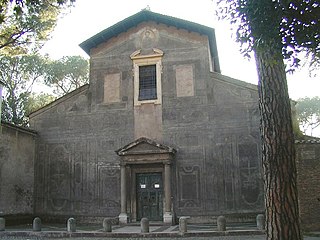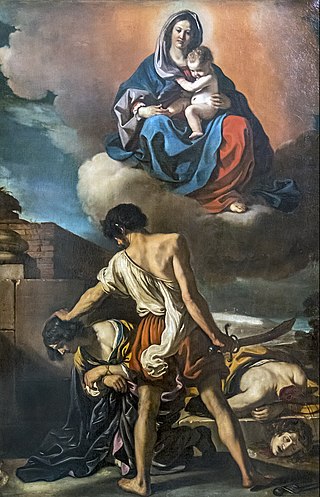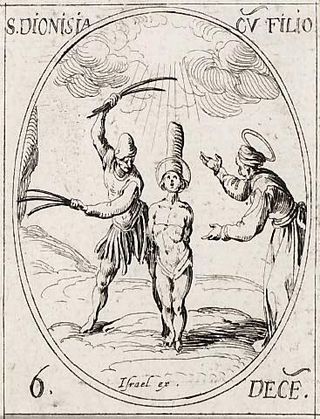
Sant'Ambrogio e Carlo al Corso is a basilica church in Rome, Italy, facing onto the central part of the Via del Corso. The apse of the church faces across the street, the Mausoleum of Augustus on Via di Ripetta.

Santi Quattro Coronati is an ancient basilica in Rome, Italy. The church dates back to the fourth or fifth century, and is devoted to four anonymous saints and martyrs. The complex of the basilica with its two courtyards, the fortified Cardinal Palace with the Saint Silvester Chapel, and the monastery with its cosmatesque cloister is built in a silent and green part of Rome, between the Colosseum and San Giovanni in Laterano, in an out-of-time setting.

San Martino ai Monti, officially known as Santi Silvestro e Martino ai Monti, is a minor basilica in Rome, Italy, in the Rione Monti neighbourhood. It is located near the edge of the Parco del Colle Oppio, near the corner of Via Equizia and Viale del Monte Oppio, about five to six blocks south of Santa Maria Maggiore.

Santi Nereo ed Achilleo is a fourth-century basilica church in Rome, Italy, located in via delle Terme di Caracalla in the rione Celio facing the main entrance to the Baths of Caracalla. It has been the titular church of Cardinal Celestino Aós Braco since 28 November 2020.

The Four Crowned Martyrs or Four Holy Crowned Ones were nine individuals who are venerated as martyrs and saints of Early Christianity. The nine saints are divided into two groups:
- Severus, Severian(us), Carpophorus (Carpoforus), Victorinus
- Claudius, Castorius, Symphorian (Simpronian), Nicostratus, and Simplicius

Martina of Rome, a patron saint of Rome, was martyred in 226, according to some authorities, more probably in 228, under the pontificate of Pope Urban I, according to others. Her feast day is January 30.

John and Paul are saints who lived during the fourth century in the Roman Empire. They were martyred at Rome on 26 June. The year of their martyrdom is uncertain according to their Acts; it occurred under Julian the Apostate (361–363).

Pammachius was a Roman senator who is venerated as a saint in the Eastern Orthodox and Roman Catholic Churches. He married Paulina. After her death, he gave himself up to works of charity.

Santi Marcellino e Pietro al Laterano is a Roman catholic parish and titular church in Rome on the Via Merulana. One of the oldest churches in Rome, it is dedicated to Saints Marcellinus and Peter, 4th century Roman martyrs, whose relics were brought here in 1256.
Abdisho and Abda were two successive bishops of Kashkar who were martyred along with 38 companions in 376 during the Forty-Year Persecution in the Sasanian Empire.

Saints Marcellinus and Peter are venerated within the Catholic Church as martyrs who were beheaded. Hagiographies place them in 4th century Rome. They are generally represented as men in middle age, with tonsures and palms of martyrdom; sometimes they hold a crown each.

The Basilica of Saints John and Paul on the Caelian Hill is an ancient basilica church in Rome, located on the Caelian Hill. It was originally built in 398.

The First Martyrs of the Church of Rome were Christians martyred in the city of Rome during Nero's persecution in 64. The event is recorded by both Tacitus and Pope Clement I, among others. They are celebrated in the Roman Catholic Church as an optional memorial on 30 June. The Orthodox Church celebrates them on 30 June in its liturgical calendar as pre-1054 East-West Schism Western saints

Saints Victoria, Anatolia, and Audax are venerated as martyrs and saints by the Catholic Church and Eastern Orthodox Church. Victoria and Anatolia are mentioned in the Roman Martyrology under the date of 10 July. Anatolia was first mentioned in the De Laude Sanctorum composed in 396 by Victrice (Victricius), bishop of Rouen (330–409).

Felicula was a probably fourth-century Roman martyr whose relics Pope Gregory I gave to Bishop John of Ravenna in about 592. She is mentioned in the Roman Martyrology on 13 June: "On the seventh milestone from the city of Rome on the Via Ardeatina, Saint Felicula, martyr".

Eleutherius, also written as Eleutherus, Eleuterus and Eleftherios; sometimes called Liberalis or Liberator, the former transliterations and the latter translations of his and his mother Antia are venerated as Christian saints and martyrs in Greece and Albania.

Denise, Dativa, Leontia, Tertius, Emilianus, Boniface, Majoricus, and Servus are venerated as martyrs by the Catholic Church. They were killed in the late 5th century during the persecution of Trinitarian Christians in Proconsular Africa by the Arian Vandals, according to Victor of Vita. These martyrs were killed during the reign of Arian king Hunneric.

Saint Firmina is a Roman Catholic Italian saint and virgin martyr. She is the patron saint of Civitavecchia, and Amelia Cathedral is dedicated to her.

Edvige Carboni was an Italian Roman Catholic from Sardinia who relocated to Rome and became well known among the faithful and religious alike for her ecstasies and angelic visions. She recorded an extensive spiritual journal in which she recorded appearances from Jesus Christ as well as saints such as Gemma Galgani and John Bosco. Carboni also experienced demonic experiences and was said to have stigmata.

The Martyrs of Albania were a collective group of 38 individuals killed during the Communist regime in Albania from 1945 until 1974. All were born at various times between 1874 and 1935; the group included Albanians and Italians as well as one German. Each of these individuals, apart from four, were part of the religious life as either priests or religious and served as either missionaries or educators with a great deal spending their educational formation in Italian and Austrian cities.



















